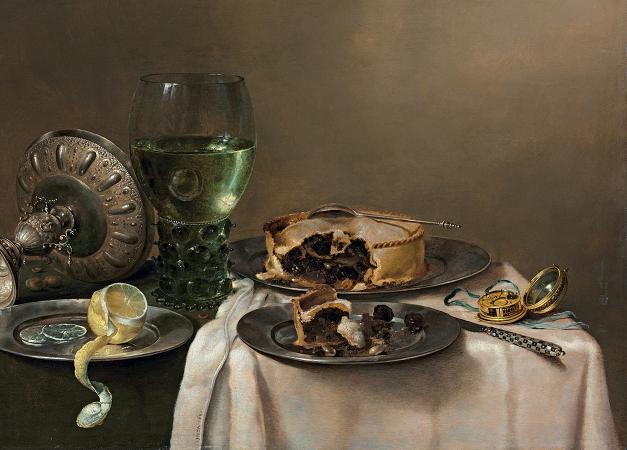Willem Claesz Heda (c1593 - c1681). Willem Claesz. Heda was a Dutch Golden Age artist from the city of Haarlem devoted exclusively to the painting of still life. He is known for his innovation of the late breakfast genre of still life painting. Heda was born in Haarlem, the son of the Haarlem city architect Claes Pietersz. His mother Anna Claesdr was a member of the Heda family. His uncle was the painter Cornelis Claesz Heda. Heda's early life is all but unknown, with no surviving pieces dated to that period. Judging from his date of birth, scholars have speculated that Heda began painting around 1615. His earliest known work was a Vanitas which fit the monochromatic and skillful texturing of his later pieces, but portrayed a subject matter distinct from the depictions of more sumptuous objects in his later years. This Vanitas, and the two other breakfast pieces by Heda in the 1620s were known for their clear deviation from earlier breakfast-pieces. The objects in these works demonstrate greater special effect and maintain a sense of balance for the viewer despite the uneven and diagonal grouping of objects. Additionally, these works adopted the monochromatic style contrary to early breakfast-pieces. Heda's skill was recognized early on in his career by other notable figures in Haarlem, such as Samuel Ampzing, a Dutch minister and poet from Haarlem, who captured the city in poetry. Heda won enough local fame in his own day for Ampzing to praise him in the same breath with Salomon de Bray and Pieter Claesz in his 1628 Beschryvinge ende lof der stad Haerlem in Holland. ha to praise Heda with the banquet pieces of Solomon de bray and Pieter Claesz, their skill deserves to be mentioned in his poem. Following his support from Samuel Ampzing, Heda became a member of the Haarlem Guild of St. Luke.As evidenced by his signing of a new charter to regularize the affairs of the guild on May 22, 1631, Heda was an active member of the Haarlem Guild of St. Luke. Following his formative pieces of the 1620s, Heda reached his artistic maturity in the 1630s with pieces such as his 1631 still-life and those of the 1639 group' sold to Vienna in the 1930s. These pieces contain perfectly draped fabric and assortments of fine glass and metal wares in addition to orderly-presented foodstuffs. This set of paintings is characterized by a sublime simplicity and order that few artists of his genre ever obtained. His coloration and illustration of light in the pieces, combined with fine additive brush strokes, results in an almost unbelievable level of realism. Heda's style continued to progress with his pieces of the 1640s developing a great simplicity founded upon a firm construction built up on broad lines. In this time, he also began to incorporate the crinkled napkin and knocked-over vases to his set of objects. This new set of objects presented a challenge to the artist to maintain cohesion and order in a clearly disordered environment. Though remnants of his more intimate pieces remained in this period, Heda began to add more objects to his works, experimenting with modified compositional styles. The 1650s saw the introduction of a wider color-scheme. This change brought more fruit and curled leaves to his works, which combined with the crinkled napkins of the previous decade, resulted in a less firm character. Heda's final years saw the artist begin the transition from the late breakfast still-life paintings he helped create, to the pronk, or display, still-life pieces of Willem Kalf in Amsterdam. His last known works were painted in 1664 and 1665, and contained the warmer pallette of browns associated with Kalf's pieces. Though he lived until the 1680s, Heda's last known paintings were created in the 1660s. Heda died in Haarlem in 1680 or 1682. Willem was a contemporary and comrade of Dirck Hals, akin to him in pictorial touch and technical execution. But Heda was more careful and finished than Hals, showing considerable skill and taste in the arrangement and colouring of his chased cups, beakers and tankards of both precious and inferior metals. Heda was also associated with the Haarlem artist and fellow still life painter, Floris van Dyck. In his work, Harlemias, the Dutch poet Theodorus Schrevelius acknowledged exceptional skill at his genre of painting. Heda and his contemporary and fellow still life painter, Floris van Dyck, were held in high esteem by the community as the best at painting their genre. As a painter of ontbijt or breakfast pieces, he is often compared to his contemporary Pieter Claesz. One of Heda's early masterpieces, dated 1623 and in Alte Pinakothek, Munich, is as homely as a later one of 1651 in the Liechtenstein Gallery at Vienna. A more luxurious repast is aLuncheon in the Augsburg Gallery, dated 1644.
more...













